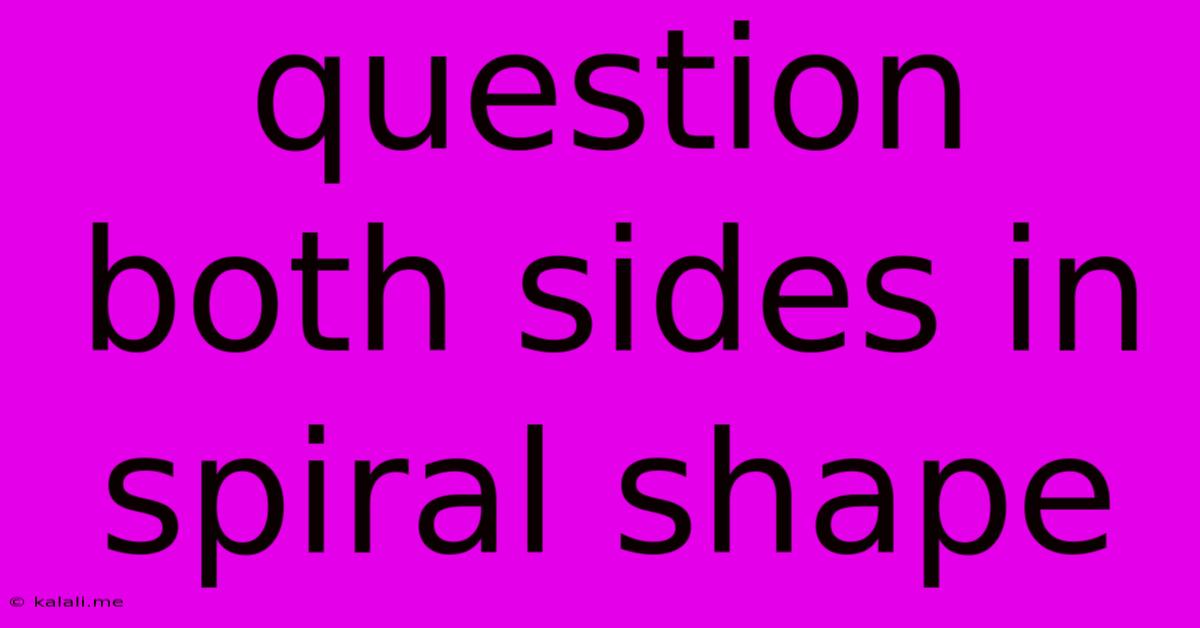Question Both Sides In Spiral Shape
Kalali
May 19, 2025 · 3 min read

Table of Contents
Question Both Sides in a Spiral: A Deeper Dive into Critical Thinking
This article explores the power of the "spiral method" in critical thinking, a technique that encourages a deeper understanding of complex issues by systematically questioning both sides of an argument in a cyclical, expanding manner. It’s more than just considering opposing viewpoints; it’s about building a comprehensive understanding through iterative questioning and refinement. This approach is invaluable for anyone seeking to improve their analytical skills and make more informed decisions.
Understanding the Spiral Method
The core principle lies in the iterative nature of the questioning process. Instead of a simple pro/con list, the spiral method encourages a deeper dive into each side. You begin with a central question or proposition, then explore the supporting arguments for one side. However, instead of simply moving to the other side, you delve deeper, questioning the assumptions, evidence, and implications of the arguments you've already examined. This questioning generates new questions, leading to further exploration of both sides in a constantly expanding spiral. Think of it as peeling back layers of an onion, revealing more nuanced perspectives with each turn.
How to Implement the Spiral Method Effectively
Here’s a step-by-step guide to help you apply this powerful technique:
-
Identify the Central Question: Clearly define the core issue you want to analyze. Ensure it's well-defined and avoids ambiguity. For example, instead of "Is climate change real?", a better question might be: "What are the most significant contributing factors to the observed increase in global average temperatures, and what are the most effective mitigation strategies?"
-
Explore One Side: Begin by thoroughly investigating one side of the argument. Gather evidence, identify key arguments, and explore the underlying assumptions. Document everything to maintain clarity.
-
Question the Assumptions: This is crucial. Don't just accept the arguments at face value. Challenge the underlying assumptions, biases, and potential limitations of the evidence presented. Ask yourself: "What if this assumption is wrong? How would that change the argument?"
-
Explore the Other Side: Now, shift your focus to the opposing viewpoint. Repeat steps 2 and 3, applying the same rigorous questioning to the opposing arguments and assumptions.
-
Identify Common Ground and Points of Divergence: After exploring both sides, identify areas of agreement and disagreement. This helps you understand the core issues separating the viewpoints.
-
Iterate and Refine: The spiral continues. The insights gained from questioning one side often reveal new questions that require further exploration of both sides. This iterative process leads to a deeper and more nuanced understanding.
-
Synthesize Your Findings: Finally, synthesize your findings into a coherent understanding of the issue. This might involve identifying strengths and weaknesses of each perspective, proposing compromises, or formulating your own informed opinion.
Benefits of Using the Spiral Method
The spiral method offers significant advantages over simpler approaches to critical thinking:
- Deeper Understanding: By iteratively exploring both sides, you develop a far more comprehensive understanding of the issue, moving beyond superficial arguments.
- Reduced Bias: The rigorous questioning process helps to mitigate personal biases by forcing you to confront and challenge your own assumptions.
- Improved Decision-Making: A deeper understanding leads to better-informed decisions, as you're less likely to be swayed by simplistic or incomplete arguments.
- Enhanced Communication: The ability to articulate the nuances of complex issues is significantly enhanced by this method.
Conclusion
The spiral method of questioning both sides isn't a quick fix; it requires time, effort, and a commitment to rigorous analysis. However, the rewards – a deeper understanding, reduced bias, and improved decision-making – make it a valuable tool for anyone striving for more effective critical thinking. By embracing this cyclical process, you can navigate the complexities of any issue with greater clarity and confidence.
Latest Posts
Latest Posts
-
How Many Combinations For 6 Numbers
May 19, 2025
-
Can You Put Silicone On Top Of Silicone
May 19, 2025
-
What To Do After Driving Through Water
May 19, 2025
-
Integral Of Ln X 2 X 2
May 19, 2025
-
How To Get Tile Paint Off Tiles
May 19, 2025
Related Post
Thank you for visiting our website which covers about Question Both Sides In Spiral Shape . We hope the information provided has been useful to you. Feel free to contact us if you have any questions or need further assistance. See you next time and don't miss to bookmark.